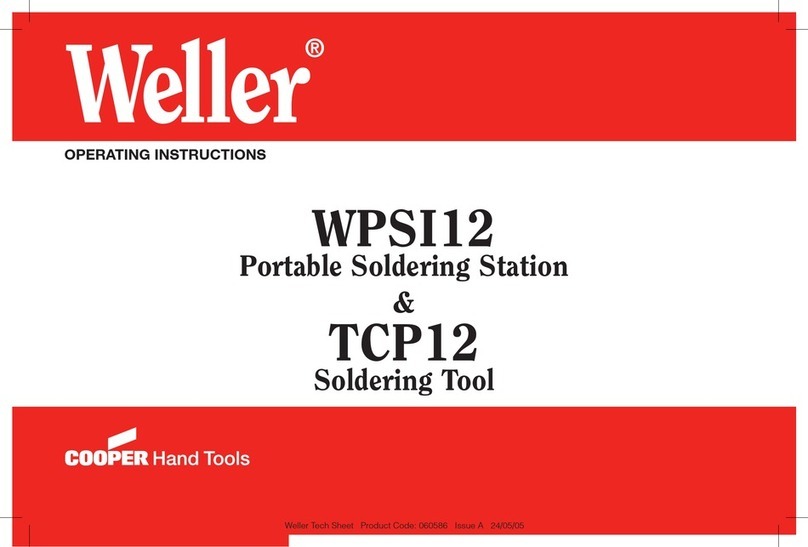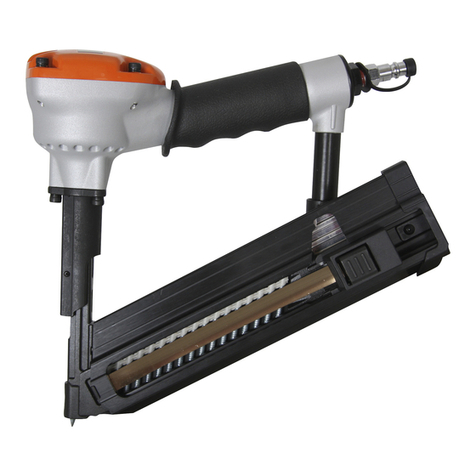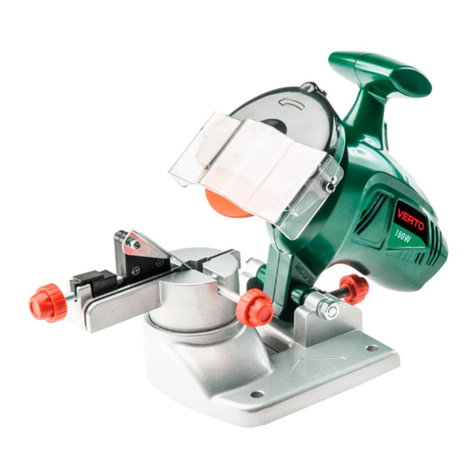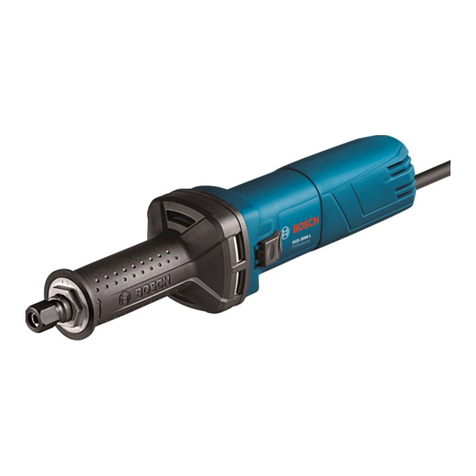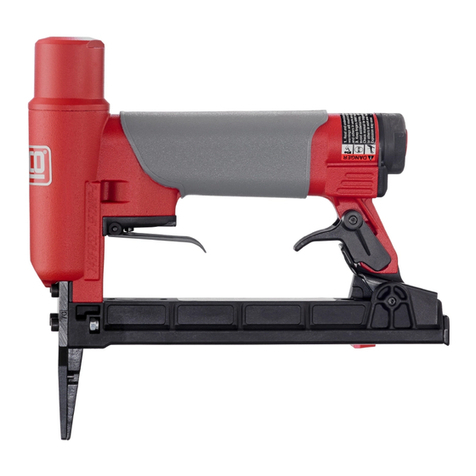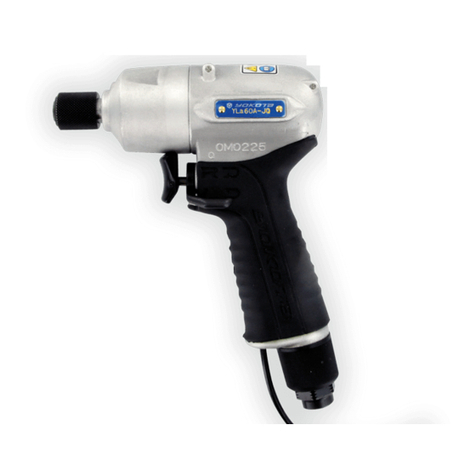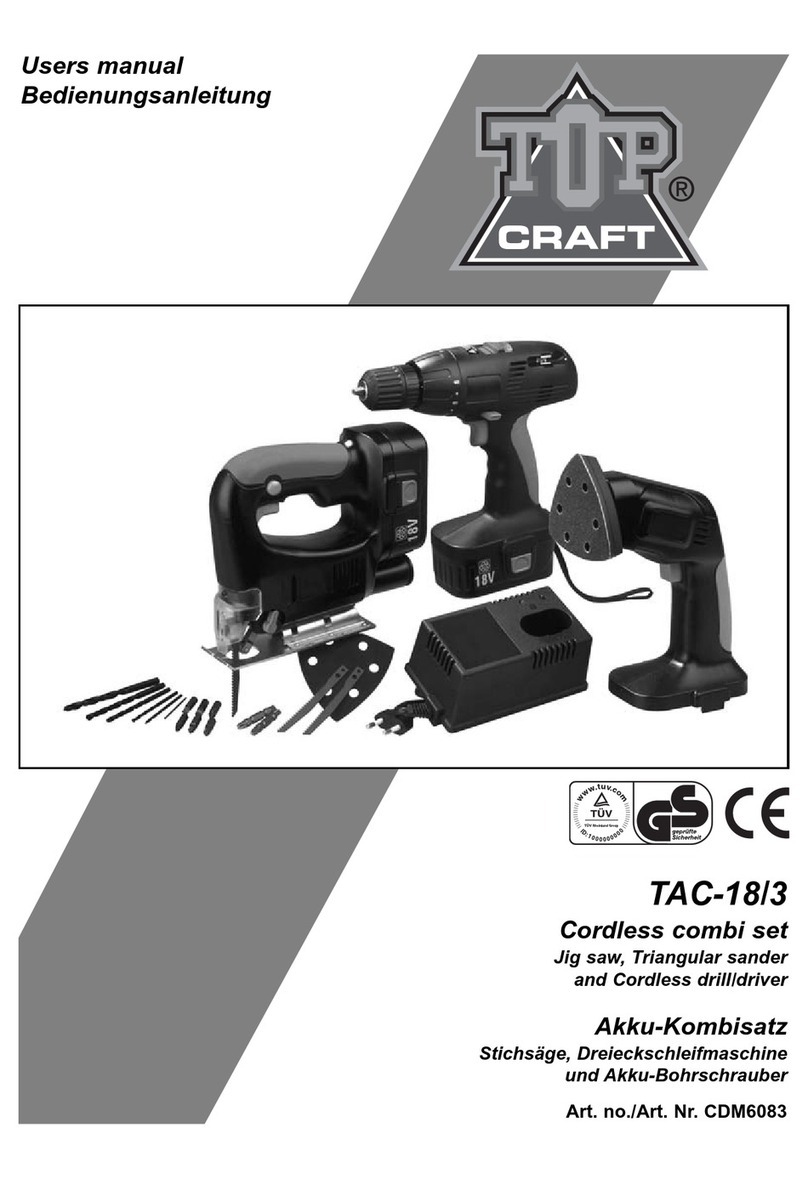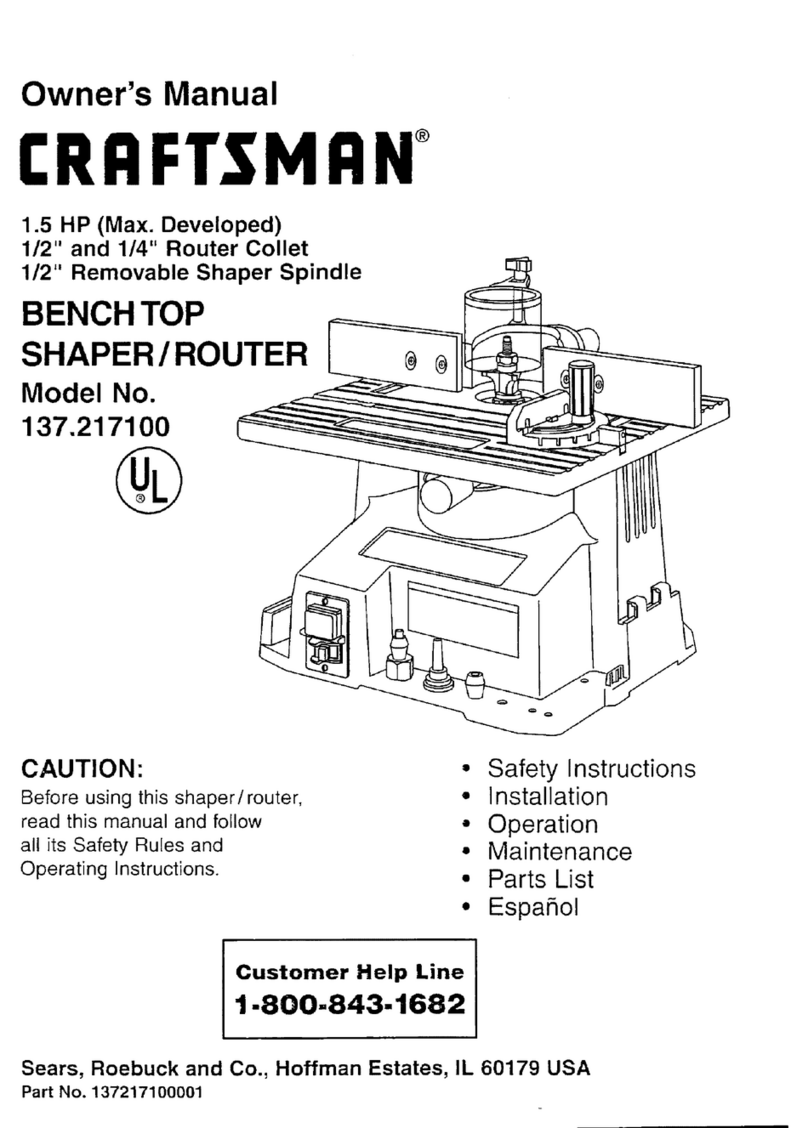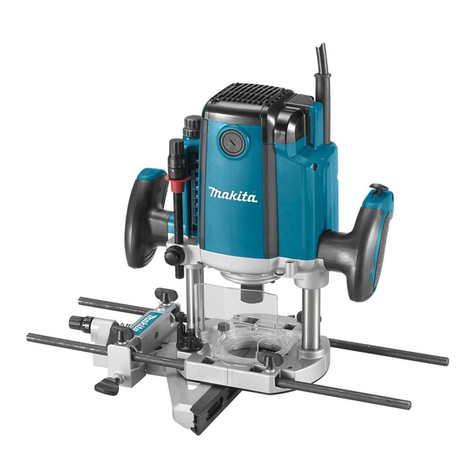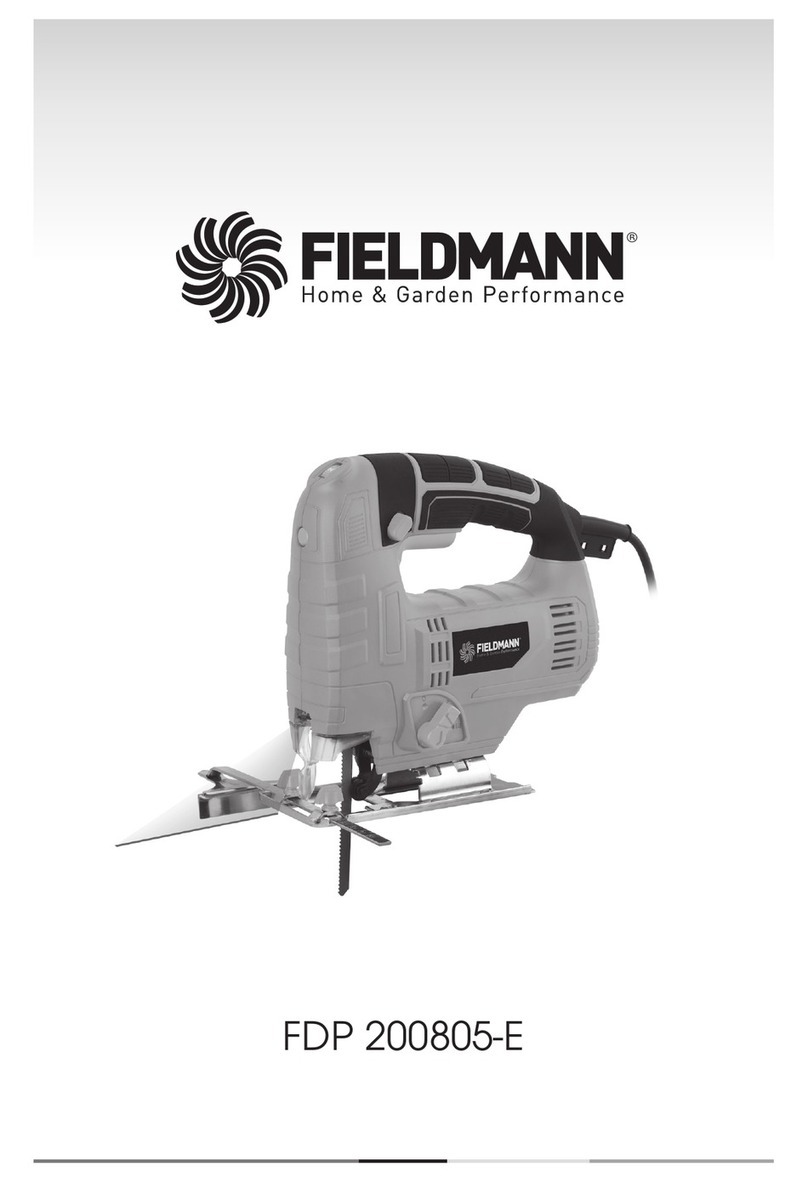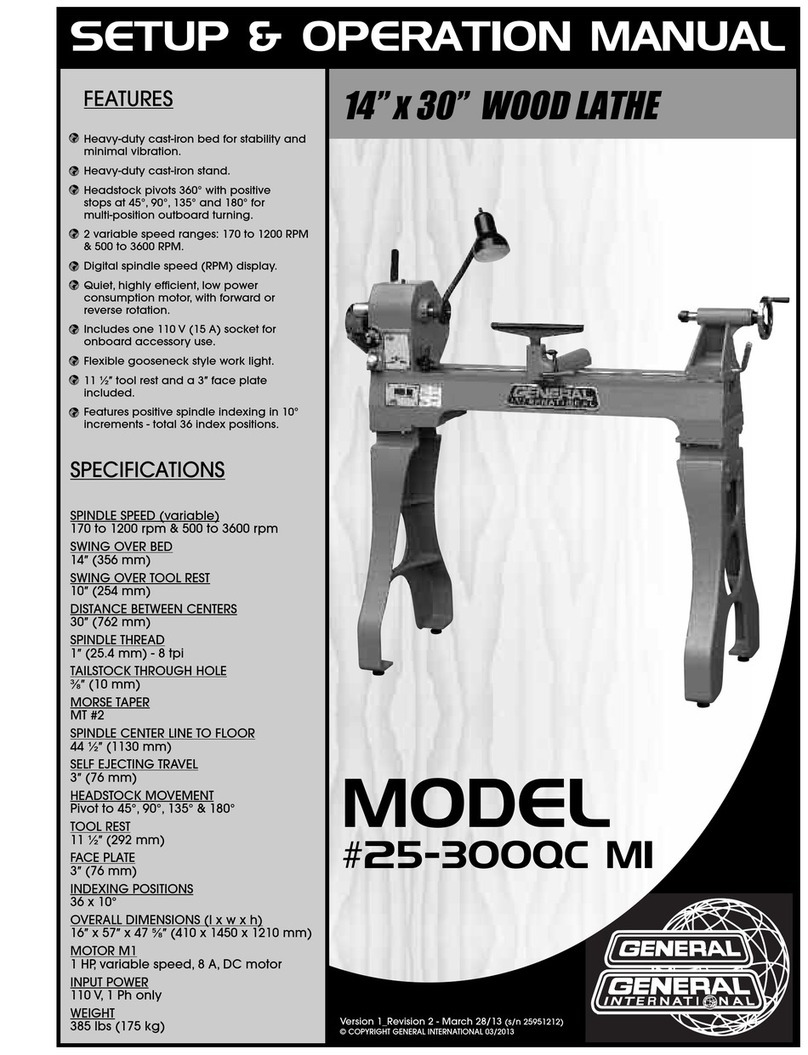Goldschmidt WT 1400 P User manual

OPERATING MANUAL ................................... Page 4
BETRIEBSANLEITUNG ................................. Seite 46
ENGLISHDEUTSCH
ENGLISH
TORQUE WRENCH
WT 1400 P
DREHMOMENT-SCHRAUBMASCHINE
WT 1400 P

2 3
ENGLISHDEUTSCH
Goldschmidt Thermit Group Companies
Europe
Elektro-Thermit GmbH & Co. KG
Chemiestr. 24
06132 Halle (Saale)
Germany
Phone +49 (0) 345 7795-600
Fax +49 (0) 345 7795-770
www.elektro-thermit.de
Form-Thermit Spol s.r.o.
Gromešova 6a
62100 Brno
Czech Republic
Phone +420 541 226 329
Fax +420 541 321 515
www.goldschmidt-thermit.com
Goldschmidt Thermit Railservice GmbH
Niederlassung Essen
Rotthauser Str. 142
45309 Essen
Germany
Phone +49 (0) 201 74796-0
Fax +49 (0) 201 74796-62
www.gt-railservice.com
Goldschmidt Thermit Railservice (France) Sarl
12 rue du Bois du Pont, Lot N° 27
Z.A. des Béthunes
95310 Saint-Ouen-l‘Aumône
France
Phone +33 (0)1 3464 1288
Fax +33 (0)1 8424 0391
www.gt-railservice.com
Goldschmidt Thermit Railservice (Österreich) GmbH
Erlaaer Straße 161
1230 Wien
Austria
Phone +43 (0) 1 6677531-0
Fax +43 (0) 1 6677531-55
office.at@gt-railservice.com
www.gt-railservice.com
GT-ATS OOO
Radishcheva Str. 19, Pushkin
Saint- Petersburg 196602
Russia
Phone +7 (812) 454-10-36
Fax +7 (812) 454-10-36 ext. 104
www.gt-ats.ru
MÁV-Thermit Kft.
Tolmács u. 18
2030 Érd
Hungary
Phone +36 (0) 23 521450
Fax +36 (0) 23 521460
www.mav-thermit.hu
Thermit Italiana s.r.l.
Via Sirtori, 11
20017 Rho Milano
Italy
Phone +39 02 93180932
Fax +39 02 93501212
www.thermit.it
Thermit Welding (GB) Ltd.
87 Ferry Lane
Rainham
Essex RM13 9YH
Great Britain
Phone +44 (0) 1708 522626
Fax +44 (0) 1708 553806
www.thermit-welding.com
Goldschmidt Thermit GmbH Oficina Ibérica
Carretera de Fuencarral, 44 – Edificio 7 – Loft 20
28108 Alcobendas – Madrid
Spain
Phone +34 (0) 663 941 573
www.goldschmidt-thermit.com
Goldschmidt Thermit Polska z o.o.
ul. Bolesława Chrobrego 94
87-100 Toruń
Polska
Phone +48 608 452459
www.goldschmidt-thermit.com
Africa Asia
Thermitrex (Pty) Ltd.
39 David Road
Boksburg-East
Gauteng
South Africa
Phone +27 (0) 11 9142540
Fax +27 (0) 11 9142547
www.thermitrex.co.za
Goldschmidt-Thermit Japan, Co., Ltd.
Ema Tanaka Building 2F
2-5-2, Iidabashi Chiyoda-ku
102-0072 Tokyo
Japan
Phone +81 (0) 3 35113305
Fax +81 (0) 3 35113390
www.goldschmidt-thermit.co.jp
Thermit China Co., Ltd.
97 Sanxiang Road
KETDZ, Kunshan
Jiangsu 215300
China
Phone +86 (0) 512 57637678
Fax +86 (0) 512 57638949
www.thermit-china.com.cn
America
Orgo-Thermit Inc.
3500 Colonial Drive North
Manchester, New Jersey 08759
USA
Phone +1 (0) 732 6575781
Fax +1 (0) 732 6575899
www.orgothermit.com
PortaCo, Inc.
1805 2nd Avenue North
Moorehead, Minnesota 56560
USA
Phone +1 (0) 218-236-0223
Fax +1 (0) 218-233-0233
www.portaco.com
Thermit do Brasil Ind. e Com. Ltda.
Rua Sargento Silvio Hollenbach 601
21530-200 Rio de Janeiro
Brazil
Phone + 55 (0) 21 24724912
Fax + 55 (0) 21 24724901
www.thermit.com.br
Australia / Oceania
Thermit Australia Pty. Ltd.
170 Somersby Falls Road
Somersby
New South Wales, 2250
Australia
Phone +61 (0) 2 43404988
Fax +61 (0) 2 43404004
www.thermit.com.au

4 5
Year of manufacture: 2016
Document no.: 1-DE-GOL-WT1400P-EN-DE-REV1
Version: 1.0
Issue date: 2016-03-01
TORQUE WRENCH
WT 1400 P
Operating manual for qualified personnel
Change history
Version Date Change/description Approval
OPERATING MANUAL
TORQUE WRENCH WT 1400 P
MACHINE FOR TIGHTENING AND LOOSENING OF RAIL ANCHORS
(SLEEPER BOLTS) ON RAILWAY TRACKS
ENGLISHDEUTSCH

6 7
TORQUE WRENCH WT 1400 P
1 Safety instructions ............................................................................... 10
1.1 Intended use ....................................................................................................10
1.2 Use other than the intended use .................................................................. 10
1.3 Further regulations ......................................................................................... 10
1.4 General causes of risk ....................................................................................11
1.4.1 Danger to life .......................................................................................11
1.4.2 Risk of injury .........................................................................................11
1.4.3 Danger of burns ................................................................................... 12
1.4.4 Risk of pollution .................................................................................... 12
1.5 Safety signs ..................................................................................................... 12
1.6 General rules of conduct ............................................................................... 14
1.7 Qualification of the personnel ...................................................................... 14
1.7.1 Operator ............................................................................................... 14
1.7.2 Operating personnel ........................................................................... 15
1.7.3 Maintenance personnel ...................................................................... 15
1.8 Personal protective equipment ..................................................................... 16
1.9 Safety devices and systems ........................................................................... 16
1.10 Fire extinguishers ............................................................................................ 17
1.11 Correct behavior in the event of an emergency ......................................... 17
2 Product description ............................................................................. 18
2.1 Function of the machine ................................................................................ 18
2.2 Accessories ......................................................................................................18
3 Specifications ....................................................................................... 20
4 Operating conditions ........................................................................... 21
5 Transport .............................................................................................. 21
5.1 Carrying fixtures on the machine .................................................................21
5.2 Carrying out transport .................................................................................. 22
6 Operation ............................................................................................. 23
6.1 Operating and adjusting elements .............................................................. 23
6.2 Operating settings ......................................................................................... 25
6.3 Commissioning ...............................................................................................25
6.3.1 Prior to commissioning .......................................................................25
6.3.2 Daily commissioning ...........................................................................25
6.4 Placing the trolley on the railway tracks ..................................................... 26
6.5 Placing the machine on the trolley ...............................................................27
6.6 Starting the machine .....................................................................................28
6.7 Correct operation of the machine ................................................................ 29
6.7.1 Loosening the sleeper bolts ................................................................ 29
6.7.2 Tightening the sleeper bolts ............................................................... 30
6.8 Switching off the machine ............................................................................. 30
6.8.1 Switching off the machine in an emergency .....................................30
6.8.2 Switching off the machine in a normal case .....................................31
6.9 Removing the machine from the railway track ..........................................31
6.10 Replacing the socket wrench insert .............................................................32
6.11 Setting up workplace lighting for the machine ..........................................33
6.12 Filling in operating fluids and consumable materials ............................... 33
6.12.1 Check and fill in fuel .......................................................................... 33
6.12.2 Check and fill in engine oil ................................................................34
6.12.3 Lubricating the machine ................................................................... 35
6.13 Check and clean the air filter ........................................................................ 36
7 Troubleshooting ................................................................................... 37
8 Cleaning .............................................................................................. 39
9 Inspection and maintenance ............................................................... 39
10 Spare and wearing parts .................................................................... 42
11 Storage ................................................................................................. 42
12 Disposal .............................................................................................. 43
13 CE Declaration of conformity .............................................................. 45
Copyright © 2016 Goldschmidt Thermit GmbH
IMPRINT
Publisher: Goldschmidt Thermit GmbH,
Hugo-Licht-Str. 3, 04109 Leipzig, Germany
Phone: +49 (0)341 355918-0
Fax: +49 (0)341 355918-99
E-mail: [email protected]
Managing Directors: Dr. Hans-Jürgen Mundinger, Dr.-Ing. Martin Niederkrüger
OPERATING MANUAL
ENGLISHDEUTSCH

TORQUE WRENCH WT 1400 P OPERATING MANUAL
8 9
The following symbols are used in this operating manual:
Table 1: General symbols
General notes for the manual
This operating manual contain all the information for use in
the intended manner and for the professional inspection of
the Torque Wrench WT 1400 P.
Please note the following points:
– The operating manual is a part of the Torque Wrench
WT 1400 P.
– The manuals must be stored close to the machine for the
complete life time of the machine.
– The manuals must be passed on to other operators of
the machine and complemented with content specific
to the operator.
– The operating manual must always be available to
the user.
This operating manual
represents the main document
required to use the machine.
Using the operating manual
The information contained in this operating
manual is binding. Each person who carries out
work on the machine or has other contact with
the machine must have read and understood
the operating manual beforehand. The instructions, rules
and prohibitions of the operating manual must always be
observed and all safety instructions must be observed.
Copyright
This operating manual is protected by the copyright of
Goldschmidt Thermit GmbH. Reproduction of the document
in part or in whole and/or transfer to a third party is only
permitted with the prior written approval of Goldschmidt
Thermit GmbH.
Use of trademarks
The names of companies and products used in this document
may be registered trademarks of the respective owner.
Warranty
Warranty obligations are valid as required by law. Damage
caused by wear through use of the machine is excluded from
the warranty.
The Goldschmidt Thermit GmbH accepts no responsibility,
does not give a warranty and releases itself from possible
third party claims if injuries to persons and damage to prop-
erty are the result of one or more of the following causes
by the operator or a third party:
– improper use of the machine,
– non-observance of the instructions of this operating
manual,
– non-observance of the stipulated application limits
and conditions,
– improper commissioning, operation, inspection or
maintenance of the machine,
– non-observance of the stipulated inspection and
maintenance intervals,
– modifications to the machine or individual components
which are not expressly approved by Goldschmidt
Thermit GmbH, or
– use of unapproved accessories or unapproved
spare parts.
Product identification –
identification plate
A identification plate is attached to the machine which
bears the exact product identification. In the event the iden-
tification plate suffers any damage or is removed, the opera-
tor must ensure that the identification plate is replaced. The
specifications listed on the identification plate must always
be stated when corresponding with the manufacturer or the
customer service.
The following figure shows the identification plate for the
Torque Wrench WT 1400 P.
Figure 1: WT 1400 P identification plate
The identification plate is located in the following position:
Figure 2: Location of the identification plate
Scope of delivery
The following articles are supplied by Goldschmidt Thermit
Group sales companies and belong to the Torque Wrench
WT 1400 P:
– Torque Wrench WT 1400 P
– Technical documentation:
» Original operating manual,
» Spare parts catalogue,
» Brief instruction,
» Manual of the engine manufacturer,
– Trolley
The machine is delivered in a fully assembled condition.
A trolley must be ordered for the machine in order to operate
it. Two versions are available (see Chapter 2.2 “Accessories”
on page 18).
Symbols in this manual
Observe the symbols and short forms used in the operating
manual. The safety symbols are based on the DIN ISO 3864
standard and are essentially identical to the safety signs on
the machine (see Chapter 1.5 “Safety signs” on page 12).
The descriptions after this symbol contain very important
information / specifications, particularly in respect of safety.
Failure to comply with these can lead to:
– The risk of injury to the operating personnel,
– The loss of contractual warranty cover,
– Rejection of liability by the manufacturer.
Symbol Definition
DANGER
DANGER describes a hazard
with a high level of risk which if
not avoided could result in death
or serious injury.
WARNING
WARNING describes a hazard
with a medium risk which if not
avoided could result in death or
serious injury.
CAUTION
CAUTION describes a hazard
with a low level of risk which
if not avoided could result in a
minor or moderate injury.
NOTE
This note describes a measure
which if not observed can lead
to environmental damage or
damage to property.
NOTE A general remark with a useful tip
and extra information.
Prohibition sign: Indicates pro-
hibition of an action in order to
avoid a hazard.
Mandatory sign: Indicates that
an action must be made in order
to avoid a hazard.
Read the safety instructions
before using the machine. Non-
observance can lead to injury
and damage to property.
NOTE
ENGLISHDEUTSCH

10 11
1 Safety instructions
This chapter includes all the information relevant for safety.
Read the safety instructions carefully before using the
machine and observe the instructions during use. The safety
instructions draw attention to the risk of possible injuries
for persons, damage to property and environmental damage
and include information on how to avoid and avert danger.
The representation and structural content of the safety
instructions are based on the DIN ISO 3864 and DIN EN
82079 standards.
1.1 Intended use
The machine may only be operated taking into account the
conditions of use (see Chapter 4 “Operating Conditions” on
page 21).
The machine is exclusively technically designed for tight-
ening and loosening retaining elements (sleeper bolts) on
railway tracks. The machine must only ever be used when
mounted on a trolley in accordance with specifications.
It must only be used and operated for this purpose. Any
other form of use, or any more extensive form of use, of this
machine or of its individual components does not constitute
“intended use”.
The manufacturer accepts no
liability for use which is contrary
to the intended use and there-
fore the operator bears the full
responsibility.
1.4 General causes of risk
In the design process for the machine all of the safety
standards for the avoidance of injury to persons, damage
to property and environmental damage were taken into
account. In spite of this, residual risk cannot be excluded.
Always work cautiously with the machine and observe the
following safety instructions.
1.4.1 Danger to life
Danger to life when working on railway tracks
Work on railway tracks includes the risk that persons can have
contact with passing trains which can lead to the most serious
injuries including fatal injuries.
– Before working on the track bed always ensure that
the railway track is out of service and reserved for work
on the track. Never work on railway tracks which are
currently released for railway traffic.
– Always proceed with the utmost caution if there are
railway tracks near to the workplace which are released
for railway traffic.
– Always place equipment and materials so that a collision
with other railway vehicles is not possible.
Risk to life from electric shocks
When working on parts and cables carrying live voltage
there is the risk of serious injury due to electric shocks which
can lead to ventricular fibrillation, cardiac arrest or respiratory
paralysis resulting in loss of life.
– Never use the machine when a power rail at the
workplace is under power.
– Never use the machine on a track circuit which is
carrying live voltage.
– Always ensure that there is no risk of an electric shock.
1.2 Use other than the intended use
Use other than the intended use is defined as when the
machine is used for a purpose which is different to the use
as described in Chapter 1.1 “Intended use” on page 10.
Examples of use other than the intended use include:
– Tightening or untightening of objects or materials other
than sleeper bolts,
– Use of the machine as a drive unit for other appliances,
– Use of the machine as a means of transport,
– Working with the machine with inadequate lighting at
the workplace,
– Working with the machine in heavy rain or snowfall,
– Use of the machine on a track that is open for rail traffic,
– Use of the machine in the DC current circuit,
– Use of the machine when a conductor rail is present,
– Use of the machine on a gradient higher than 4% or more,
– Use of the machine while being operated by anything
other than the two lifting handles with operating function,
– Use of the machine without a suitable trolley as a move-
ment device and support for the machine while on rails.
1.3 Further regulations
In addition to the information in this operating manual, the
legal regulations for accident prevention and environmental
protection and the accident prevention regulations of the
operator must be observed. The safety regulations for work-
ing on railway tracks or near to railway tracks issued by the
railway authorities must be strictly observed. The work may
only commence after the responsible safety officers have
authorized the work.
1.4.2 Risk of injury
Risk of injury through crushing of body parts
During work with the machine, if any body parts such as
hands or feet are located under the machine, this entails the
risk of serious injuries caused by crushing, broken bones and
even the severing of entire parts of the body.
– When operating this machine, never locate hands or feet
under the machine.
– Always wear workplace footwear with non-slip soles and
steel toe caps.
– Always wear protective gloves.
– When the machine is switched on, everyone except
the operator must maintain a safe distance of at least
5 meter.
When cleaning the air filter, there is the risk of injury
due to metal fragments and dust thrown up
When working with compressed air, there is the risk that
metal fragments and dust can penetrate the eyes leading to
injuries in the eye including loss of sight.
– When working with compressed air and in the area
where compressed air is in use always wear protective
glasses.
Risk of injury through falling down, slipping or sliding
When working on the track bed there is the risk of slipping
or sliding on the ballast and falling down which can lead to
injuries such as bruises or bone fractures.
– Always proceed cautiously when working with the machine.
– Do not work with the machine on gradients higher than 4%.
– Always wear robust industrial footwear with non-slip
soles and steel toe caps.
Danger of hearing damage
The A-weighted sound pressure level LPA at the workplace
can be as high as 82 dBA and the A-weighted sound power
level LWA at the workplace can be as high as 99 dBA.
The impact of noise can damage the hearing and can cause
short-term loss of hearing as well as mental overload.
– Always wear hearing protection when handling the
machine.
ENGLISHDEUTSCH
TORQUE WRENCH WT 1400 P OPERATING MANUAL
NOTE

Figure 5: Installation positions for safety signs 3
Figure 6: Installation positions for safety signs 4
Table 2: Safety signs
The following figures shows where the safety signs are
attached:
Figure 3: Installation positions for safety signs 1
Figure 4: Installation positions for safety signs 2
12 13
1.4.3 Danger of burns
Explosive or flammable substances
– Never carry out work in environments where there is a
risk of an explosion or fire.
– Always ensure that no highly flammable or explosive
substances are located in the area of the machine.
– If necessary clean the workplace to remove flammable
substances and ensure sufficient ventilation.
Filling the fuel tank
If fuel is spilt when the fuel tank is filled, there is the risk
of an explosion or a fire when the machine is started imme-
diately afterwards which can lead to severe burns.
– Never fill up the tank when the engine is hot, but first
of all allow the engine to cool down.
– If necessary carefully clean all fuel from the outside of
the machine and ensure sufficient ventilation when the
engine is started again.
Hot engine
In the course of normal operation and after turning off, the
engine can be very hot and cause skin burns.
– Avoid contact to the engine directly after operation.
– Allow sufficient time for the engine to cool before starting
maintenance work.
– When working with the machine always wear protective
gloves and protective clothing.
1.4.4 Risk of pollution
The machine includes engine oil and is driven by petrol or
diesel. Mineral-based oils are hazardous for water. If petrol,
diesel or engine oil penetrates the soil, this can lead to
groundwater contamination and the penetration of hazardous
substances into the food chain.
– When filling the tank always ensure that dripping fuel
cannot penetrate the soil. If necessary, use something to
collect the drips.
– Always dispose of detergents contaminated with fuel in
the correct way.
– Always collect old oil in appropriate containers.
– Always dispose of old oil and detergents contaminated
with fuel in the correct way.
1.5 Safety signs
The machine must have safety signs in accordance with the
requirements of the standards ISO 7010 and ISO 3864.
Make sure the safety signs are
in place. If, during the life of the
machine, safety signs become
damaged or are missing, the
operator must ensure they are
replaced. Regularly check the
presence and condition of
the safety signs.
The following safety signs are attached to the machine:
Safety sign Meaning
Warning sign “Hot surfaces”:
indicates that the engine of the
machine during operation and
directly after operation can be very
hot and this can lead to skin burns.
Prohibition sign “No naked flame,
fire or ignition source”: indicates
that a naked flame, fire or ignition
source may not be placed near to
the machine.
Prohibition sign “No smoking”:
indicates that smoking is prohibited
near to the machine.
Mandatory sign “Wear hearing
protection”: indicates that while
working with the machine hearing
protection must be worn by all
persons near to the machine.
Mandatory sign “Read the
operating manual”: indicates that
the operating manual must be
read and fully understood before
handling the machine.
Safety sign Meaning
Symbol “Mounting point for
transport means”: is located near
to the transport device and marks
the mounting point for the transport
means.
Information sign “PETROL”:
indicates that the machine is
driven with petrol.
NOTE
ENGLISHDEUTSCH
TORQUE WRENCH WT 1400 P OPERATING MANUAL

14 1514 15
1.7 Qualification of the personnel
The only persons allowed to handle the machine are persons
who meet the following requirements. All other persons are
not allowed to handle the machine.
– They have completely read and understood this operating
manual.
– They are in good health and in full possession of their
mental and physical powers.
– They are rested and are not under the influence of drugs,
alcohol or medicines which can impair the ability to react
or impair mental receptiveness.
– They are regularly instructed regarding complications,
hazards and special rules of conduct including the fire
protection regulations.
– They always take care to ensure an orderly workplace.
– In order to ensure occupational safety, they wear the
necessary personal protective equipment (see Chapter
1.8 “Personal protective equipment” on page 16).
– They always observe the safety and accident prevention
regulations of the employer and the statutory regulations
with regard to personal safety and the safety of other
persons.
1.7.1 Operator
The operator is the person who operates the machine for
commercial or economic purposes himself or who organizes
a third party to do the work and during operation legally
bears responsibility for the product for the protection of the
operator, operating personnel or third party.
Obligations of the operator
– The operator must be familiar with and implement
the applicable regulations for occupational safety and
accident prevention.
– He must regularly check whether the operating instruc-
tions correspond to the current status of the regulations.
– He must clearly regulate and define the responsibilities
for the correct transport, correct assembly, operation,
troubleshooting, inspection, maintenance, repair,
cleaning and disposal.
– He must ensure that the personnel have completely read
and understood the operating manual.
– He must train the personnel at regular intervals and
inform the personnel about hazards.
– He must provide the personnel with the required personal
protective equipment.
– He must store the keys necessary for operation of the
machine such that they are not available to unauthorized
persons and may only make these keys available to
authorized persons.
1.7.3 Maintenance personnel
The maintenance personnel are defined as follows:
– The maintenance personnel are trained in the areas
of electrical engineering and mechatronics or have a
qualification as a qualified industrial mechanic, i.e.:
» The maintenance personnel are qualified for the special
area where they are working and know the relevant
standards and regulations.
» Due to their technical training and experience the
maintenance personnel are able to work on machines
driven by petrol engines and to independently recog-
nize and avoid possible dangers.
» The maintenance personnel are able to completely
understand the function of the fitted safety equipment.
» The maintenance personnel are able to read circuit
diagrams and connection plans and to carry out electro
technical maintenance work with the aid of circuit
diagrams and connection plans.
» The maintenance personnel have completely read and
understood the maintenance manual.
– The maintenance personnel have the technical expertise
to handle the machine with regard to:
» assembly,
» disassembly,
» operation,
» troubleshooting,
» inspection,
» maintenance,
» repair / replacement,
» decommissioning,
» cleaning.
– The maintenance personnel receive continual training
with regard to new technical information and have the
necessary basic knowledge of the fitted technology.
– The maintenance personnel receive initial training by
your respective Goldschmidt Thermit Group sales partner
or in-company training from the employer with the focus
on the following items:
» function of the machine,
» explanation of the individual components,
» explanation of sources of risk,
» use of the machine,
» recognition of malfunctions,
» special points regarding maintenance and inspection.
1.7.2 Operating personnel
The operating personnel of the machine are defined as
follows:
– They have completely read and understood this operating
manual.
– The operating personnel have sufficient technical exper-
tise to operate the machine in all situations, are able to
remove errors and are able to clean the machine.
– The operating personnel have the authorization to
drive the means of transport required for the filling of
the machine.
– The operating personnel receive continual training with
regard to new technical information and have the necessary
basic knowledge of the fitted technology.
– The operating personnel have the technical expertise to
handle the machine with regard to:
» operation,
» error detection,
» cleaning.
– The operating personnel receive initial training by
Goldschmidt Thermit GmbH or in-company training from
the employer with the focus on the following items:
» function of the machine,
» explanation of the individual components,
» explanation of sources of risk,
» use of the machine,
» recognition of malfunctions,
» correct cleaning of the machine.
ENGLISHDEUTSCH
TORQUE WRENCH WT 1400 P OPERATING MANUAL
1.6 General rules of conduct
The following rules of conduct must always be observed by
personnel handling the machine:
– Only use the machine in the manner intended.
– Always take care to ensure your own safety and the safety
of other persons when working with the machine and
ensure cleanliness and tidiness.
– Follow all the instructions of the operator of the machine.

16 1716 17
1.8 Personal protective equipment
To the extent that the operator does not stipulate any additional
regulations, the work can be carried out with the machine using
the protective equipment listed in the following table.
In order to avoid injuries to per-
sons, a reduction in the require-
ment for personal protective
equipment may only be made
after approval from Goldschmidt
Thermit GmbH has been given.
The following protective equipment must be worn when
carrying out the “Work” as listed in the following table:
Table 3: Protective equipment
1.9 Safety devices and systems
In order to prevent injury to persons, environmental pollution
and damage to property, the following safety devices are
fitted to the machine. The pictures show where the safety
devices are on the machine.
Figure 7: Safety devices 1
Figure 8: Safety devices 2
Engine protection frame
The engine protection frame protects the engine against
damage and protects the operator against unintentional
contact with the engine. The engine can be very hot during
and immediately after operation.
Emergency stop button
The emergency stop button is a red mushroom-headed push-
button. When pressed, it shuts down the engine and, a few
seconds later, also stops the rotation of the spindle. After
the emergency stop switch has been actuated, it needs to
be released before the engine can be restarted.
1.10 Fire extinguishers
The operator must ensure that while working with the ma-
chine a functioning CO2fire extinguisher is located close to
the workplace.
1.11 Correct behavior in the event of an emergency
If there is an emergency, use the emergency-stop button or
the on / off switch to immediately switch off the machine
(see Chapter 6.1 “Operating and adjustment controls” on
page 23) and leave the danger zone as quickly as possible.
– In the event of injury to a person immediately initiate
first-aid measures.
– In the event of a fire initiate the necessary firefighting steps.
Engine protection frame
Emergency stop button
Symbol Protective
equipment
Work
Protective clothing
(close fitting to
arms and legs)
Operation,
inspection,
maintenance,
cleaning
Protective shoes
(with anti-slip soles
and steel toe cap)
Operation,
inspection,
maintenance,
transport
Protective gloves Operation,
inspection,
maintenance,
transport
Hearing protection Operation,
inspection (with
engine running)
NOTE
ENGLISHDEUTSCH
TORQUE WRENCH WT 1400 P OPERATING MANUAL

18 19
Overall design
The machine consists of the following components:
Figure 9: Overall design including trolley
Control element Function
Lifting handles Lifting the machine.
Engine protection frame The engine protection frame protects the engine against damage and protects
the operator against unintentional contact with the engine. The engine can be very
hot during and immediately after operation.
Combustion engine Machine drive.
Lifting point Lug for lifting the machine with a suitable lifting device (e.g. forklift truck, crane).
Emergency stop button Shuts down the engine immediately, and interrupts rotation of the spindle.
Lifting handles with operating
function
Lifting and operating the machine.
Control panel Setting the torque and displaying the operating hours.
Transmission stage Power transmission of the required torque.
Electro-mechanical coupling Separation between drive unit (engine) and reduction and multi-ratio gear unit (spindle).
Trolley Device for moving and supporting the machine while on railway tracks.
Electro-mechanical brake Stopping the rotation of the spindle
Reduction and multi-ratio gear unit Speed and torque can be switched in ratio steps.
Socket wrench insert Connecting element between spindle and sleeper bolt.
Reversing gear unit Gear unit for reversing the direction of rotation
2.2 Accessories
The trolly is used to move and to support the machine while
on railway tracks. A trolley is essential for the intended use
of this machine.
Trolley with 3 wheels
On trolleys with 3 wheels, the machine can only be placed
on one side of the tracks. To untighten sleeper bolts on the
opposite side, the trolley needs to be turned right around.
Trolley with 4 wheels
On trolley with 4 wheels, the machine can be directed by
the guide block to any desired point on the trolley.
Socket wrench inserts
The socket wrench sizes for the most commonly used
sleeper bolts are available and can be ordered together
with the machine. Other shapes and sizes can be produced
on request.
ENGLISHDEUTSCH
TORQUE WRENCH WT 1400 P OPERATING MANUAL
2 Product description
This chapter describes the most important components
on the machine and explains their functions. This machine
represents state-of-the-art technology. Its construction incor-
porates all applicable legislation, stipulations, specifications,
directives and guidelines. All necessary safety precautions
were taken, thereby assuring the highest possible level of
personal protection. The materials used, the equipment
components and the production, quality assurance and
inspection procedures comply with the highest standards of
safety and reliability.
2.1 Function of the machine
The machine is designed exclusively for tightening and
loosening of fixing components (sleeper bolts) on railway
tracks. The machine comprises a robust tubular frame that
supports all of the mechanical components of the machine.
An engine provides the power required for tightening and
loosening the rail anchors. The machine moves around on
railway tracks on a trolley.

Table 5: Engine data
20 21
3 Specifications
This chapter contains all of the important specifications for
the machine.
Table 4: Technical data
Technical data
Width 700 mm
Length 1950 mm
Height 850 mm
A-weighted sound pressure level
LPA at the workplace
82 dBA
A-weighted sound power level
LWA at the workplace
99 dBA
Vibration level (lifting handles) 2.2 m/s2
Tightening torque 0 to 430 Nm
Loosening torque 0 to 1400 Nm
Socket wrench
(locating point for spindle)
UNI ISO 2725-2
DIN 3129, size 1“
Empty weight 130 kg
Weight of trolley with 3 wheels 19 kg
Weight of trolley with 4 wheels 37 kg
Engine data
Engine
manufacturer
Honda
Model GX 270
Fuel Gasoline, unleaded
– Research octane figure (ROZ):
≥ 91 or
– Engine octane figure (MOZ):
≥ 86
– Ethanol (E10): ≤ 10 Vol-% or
– Methanol: 5 vol %
Output 6.3 kW
Starter manual
Tank capacity 5.3 litres
Fuel consumption
per hour
2.4 litres
Engine oil type SAE 10W-30
Engine oil capacity 1.1 litres
Transmission
oil type
ISO VG 220 type Duragear 220
Transmission
fluid capacity
0.3 litres
Transmission
grease
EP 00
Valve clearance
(when cold)
Suction 0.15 ± 0.02 mm
Exhaust 0.2 ± 0.02 mm
Spark plug type BPR6ES (NGK) W20EPR-U
(DENSO)
0.7-0,8 (0.24”-0.28”)
Idle speed 1400 ± 150 rpm
4 Operating conditions
This chapter describes the operating conditions required for
the correct operation of the machine.
If the real conditions deviate from the operating conditions,
the machine must not be used. Before commissioning the
machine always check whether all operating conditions are
observed.
Table 6: Operating conditions
The machine can be used on a railway track raised by up
to 200 mm and on a gradient of up to 4%. Under these
conditions, the machine can be held in a stable position while
in operation.
Operation of the machine under
any conditions other than those
described above is prohibited.
Using the machine in unsuitable
environments can lead to mal-
functions or to the mechanical
failure of a few components in
the machine.
Furthermore, the following conditions must be satisfied
when the machine is being operated:
– The machine must always be operated in technically
perfect condition.
– No items of protective equipment or other components
must be rendered unable to function.
– All inspection and maintenance intervals must be observed.
– The machine must be kept in a clean condition.
– The machine must not be used in an environment at risk
of fire or explosion, nor near combustible or explosive
fluids or gases.
– The working location must be well enough lit to discover
potential hazard areas in good time.
– The machine must not be operated on a gradient of 4%
or more.
– The machine must not be operated inside a tunnel.
– The machine can only be operated in good weather, light
rain or slight snowfall.
Item Value
Ambient temperature -20° C to +40° C
Relative air humidity (max) 20 % to 80 %
(without condensation)
5 Transport
This chapter includes all the information which
is required for the safe transport of the machine.
Read the instructions for the transport carefully
and observe the instructions in order to ensure
the machine has a long life.
5.1 Carrying fixtures on the machine
The machine must only be raised using the existing lifting
fixtures, identified in Figure 10: Carrying fixtures.
There are 2 possible ways of lifting the machine:
– By hand, with 4 people, using the lifting handles .
– With appropriate lifting gear, e.g. a fork truck, crane
etc. using the lifting point . During this operation, one
person must hold the machine by the lifting handles to
prevent it from swinging or rotating in an uncontrolled
manner.
Figure 10: Carrying fixtures
ENGLISHDEUTSCH
TORQUE WRENCH WT 1400 P OPERATING MANUAL
Lifting handles
Lifting point
NOTE

Switch off the machine before transport and allow it to cool
down.
To transport the machine correctly by hand, observe the
following points:
– Always use 4 people to lift the machine, each one holding
a lifting handle.
– Only transport the machine by hand for short distances,
and only when absolutely essential.
– Always transport and set down the machine in an upright
position to prevent operating fluids escaping from the
machine.
To transport the machine correctly, always use appropriate
transport equipment and observe the following points:
– Protect the machine sufficiently to prevent it from falling.
– Clear the access route for transport and ensure that no-
one can get injured.
– Always use the lifting fixtures on the machine as lifting
points.
– When transporting with lifting gear, have one person
holding the machine by the lifting handles to prevent
accidental swinging or rotating movements.
– Always transport the machine in an upright position to
prevent operating fluids escaping from the engine.
To transport the machine on a loading plate, observe the
following points:
– Secure the machine on the lifting fixtures with transport
belts so that the machine cannot drop or get damage,
and so that it remains upright.
– Never place the machine directly onto the loading
plate but instead set it down on pallets, wooden beams,
shelving units or similar items.
– When doing so, always ensure that the engine and its
control elements do not get damaged by other objects
being transported, nor by the transport belts.
22 23
5.2 Carrying out transport
Fire hazard!
After operation the engine can
be very hot. If the hot engine
comes into contact with highly
flammable materials, e.g. on
a loading surface, there is the
risk of a fire and serious injuries
caused by fire can be fatal.
–Before loading or storing allow
the engine to sufficiently cool.
–Do not place any highly
flammable materials close
to the machine.
Risk of injury!
If the machine is moved with
a means of transport and the
machine falls down, this can lead
to serious injuries which can be
fatal.
–Always secure the machine
adequately before the trans-
portation.
–Never stand under a suspended
load.
Risk of collision and crushing
injuries!
Limbs may get crushed and
parts of the body may get injured
during operation and transport.
–Exercise caution when lifting
and transporting this machine.
Crushing hazard!
The machine has sharp edges
and can fall over. If the machine
drops onto hands or feet, this can
cause crushing injuries, broken
bones or even the severing of body
parts, including hands and feet.
–Always park the machine in a
place where it cannot fall over.
–Always wear safety gloves,
safety footwear and personal
protective clothing.
Risk of burns!
The engine and adjacent compo-
nents can be very hot after oper-
ation. Physical contact with the
engine can cause burn injuries
to the skin.
–Avoid physical contact with
the engine and adjacent com-
ponents shortly after operation.
–Always wear personal protec-
tive equipment (PPE), e.g. work
gloves, safety footwear and
protective workplace clothing.
Risk of collision and crushing
injuries!
Secure the trolley to prevent it
from rolling away because this
could crush limbs and injure
body parts.
–The trolley must always be
secured sufficiently on and
beside the railway tracks.
–Always secure the trolley
sufficiently while it is being
transported.
6 Operation
This chapter includes all the necessary informa-
tion to correctly operate the machine. Carefully
read and observe all the instructions about the
operation in order to ensure a long life for the
machine.
6.1 Operating and adjusting elements
The following operating and adjustment controls are located
of the machine:
Figure 11: Operating and adjustment controls 1
Figure 12: Operating and adjustment controls 2
DANGER
DANGER
WARNING
WARNING
CAUTION
WARNING
ENGLISHDEUTSCH
TORQUE WRENCH WT 1400 P OPERATING MANUAL

24 25
Figure 13: Operating and adjustment controls 3
Figure 14: Operating and adjustment controls 4
6.2 Operating settings
On its trolley, the machine has 2 stable positions. These are
illustrated in the following illustrations.
Figure 15: Position for tightening and loosening the sleeper
bolts
Figure 16: Position for tilting and moving the machine
6.3 Commissioning
6.3.1 Prior to commissioning
Prior to first-time commissioning (after transport or storage),
check the general external condition of the machine:
1. Check for presence and legibility of identification plate
and safety labels.
2. Check the outside and the underside of the engine for
signs of oil or fuel leaks.
3. Remove excessive dirt or foreign bodies, in particular
near to the muffler and the recoil starter.
4. Look for signs of damage, e.g. cracks and breaks.
5. Check if all guards and covers are fitted and all nuts
and screws have been tightened.
– If the engine is not in perfect condition, do not start
the engine but instead restore normal condition and/or
inform maintenance personnel.
During the first hours of operation,
it is possible for the spindle to
rotate, even if the actuation
switch is released. This is because
the electromechanical brake
must first get run in.
6.3.2 Daily commissioning
Before each daily commissioning (start-up), check the engine
for fuel and consumables before each operation.
1. Check the fuel level of the engine at regular intervals
and fill in if necessary (see Chapter 6.12.1 “Check and
fill in fuel” on page 33).
2. Check the engine oil level and fill up if necessary (see
Chapter 6.12.2 “Check and fill in engine oil” on page 34).
3. Check the air filter insert and clean if necessary or
replace it (see Chapter 6.13 “Check and clean the air
filter” on page X).
Control element Function
Fuel tap To adjust the fuel feed
(2 states: left = OFF, right = ON).
Choke lever To control the air feed when
starting the engine.
(2 positions: left = OPEN,
right = CLOSED).
Throttle lever To adjust the engine speed
Engine switch Switching on the engine (2 posi-
tions: left = ON, right = OFF).
Starter handle To start the engine with a
recoil starter.
Emergency
stop button
Immediate shutdown of
the engine.
Actuation button Spindle rotation.
Direction of
rotation selector
Setting direction of spindle
rotation (2 positions: TOP = loos-
ening, BOTTOM = tightening).
Operating hours
counter
Display of operating hours.
Rotational
controller
Setting the tightening torque.
Spindle Rotating axis.
Socket wrench
insert
Connecting element between
spindle and sleeper bolt.
ENGLISHDEUTSCH
TORQUE WRENCH WT 1400 P OPERATING MANUAL
NOTE

26 27
6.4 Placing the trolley on the railway tracks
Risk of injury!
The trolley weighs up to 37 kg.
If the trolley drops onto hands
or feet, it can cause crushing
injuries or broken bones.
–Always use 2 people to lift the
trolley.
–When setting down the trolley,
keep hands and feet away
from the tracks.
–Always wear protective gloves,
protective shoes and protective
clothing.
The trolley for the machine does
not have any brakes and must
therefore never be left by the
operator unsupervised because,
if parked on a gradient, it could
start to roll away. For this reason,
always chock the wheels suffi-
ciently to prevent it from rolling
away.
The machine can be moved on railway tracks using either of
2 different trolleys.
Trolley with 3 wheels
On trolleys with 3 wheels, the machine can only be placed
on one side of the tracks. For loosening sleeper bolts on the
opposite side, the trolley needs to be turned right around.
When placing this trolley on the railway tracks, always
follow these instructions:
The trolley must always be lifted by 2 people, and placed
on the tracks at points to (see Figure 17: Trolley with
3 wheels).
– Always ensure that the wheels grip the track (see Figure
19: Trolley with 3 wheels on the track).
Figure 17: Trolley with 3 wheels
Figure 18: Trolley with 3 wheels on the track
Trolley with 4 wheels
On trolleys with 4 wheels, the machine can be directed by
the guide block to any desired point on the trolley.
When placing this trolley on the railway tracks, always
follow these instructions:
Lift the trolley using 2 people, and place on the railway track
at points to (see Figure 19: Trolley with 4 wheels).
– Always ensure that the wheels locate properly on the
railway track (see Figure 21: Trolley with 4 wheels on the
track).
Figure 19: Trolley with 4 wheels
Figure 20: Trolley with 4 wheels on the track
6.5 Placing machine on the trolley
Risk of injury!
Machine weighs up to 140 kg.
If the machine drops on hands
or feet, it can cause crushing
injuries, broken bones or even
the severing of body parts,
i.e. hands and feet.
–Always use 4 people to lift the
machine.
–Always wear protective gloves,
protective shoes and protective
clothing.
The trolley does not have any
brakes and must therefore never
be left by the operator unsuper-
vised because, if parked on a
gradient, it could start to roll
away. For this reason, always
chock the wheels sufficiently to
prevent it from rolling away.
When placing the machine on the trolley. Always follow
these instructions:
1. Place the trolley (with 3 or 4 wheels) on the tracks
(see Chapter 6.4 “Placing the trolley on the railway
tracks” on page 26).
2. Use 4 people to lift the machine, each holding one
of the lifting handles, and insert the thorn in the
machine support on the trolley (see Figure 23:
Machine support).
– On the trolley with 4 wheels, the guide block can be
locked at either end of the trolley using the lever .
CAUTION
ENGLISHDEUTSCH
TORQUE WRENCH WT 1400 P OPERATING MANUAL
NOTE
WARNING
NOTE

6.7.1 Loosening the sleeper bolts
Follow these instructions to loosen the sleeper bolts:
1. Fit the machine socket wrench over the sleeper bolt.
2. Use the direction of rotation selector to set the correct
direction of rotation for loosening (Switch position: TOP).
3. Press and hold down the actuating switch until the
sleeper bolt is loosening completely.
The machine first selects the low ratio to untighten the
sleeper bolt. Then the machine automatically shifts up into
the next ratio to unscrew the sleeper bolt.
If the sleeper bolt cannot be un-
fastened, release the actuating
button immediately.
Whenever the actuating button
is held down for an extended
period without rotation of the
spindle, the electromechanical
coupling is overloaded and,
within a few seconds, it can
reach high temperatures,
causing it to get damaged.
28 29
Figure 21: Thorn
Figure 22: Machine support
Figure 23: Locking the machine into position
6.6 Starting the machine
To start the machine, follow these instructions:
1. Move fuel tap to ON.
a. To restart the engine while hot, move the choke
lever into CLOSED position.
b. To start the engine when cold, move the choke
lever into OPEN position.
2. Move the throttle lever from MIN setting to 1/3 MAX.
3. Move the engine switch to ON.
4. Quickly pull through the starter handle . If necessary,
repeat this several times.
5. Whenever the engine is started, set the desired speed
using the throttle lever and move the choke lever
to its CLOSED position as soon as the engine has come
up to operating temperature.
Figure 24: Operating and adjustment controls 1
Figure 25: Operating and adjustment controls 2
Thorn
Retaining fixture
Guide block
Lever for locking the guide block
6.7 Correct operation of the machine
Before tightening the bolts,
check the machine torque against
the rotational controller on the
control panel and correct if
necessary.
Incorrect setting of the torque
can cause the sleeper bolts to be
tightened incorrectly, and they
may even break off.
The trolley for the machine does
not have any brakes and must
therefore never be left by the
operator unsupervised because,
if parked on a gradient, it could
start to roll away. For this reason,
always chock the wheels suffi-
ciently to prevent it from rolling
away.
The clockwise direction of rotation
is used to tighten. The anti-clock-
wise direction of rotation is used
to loosen.
The display of operating hours
continues to run with each oper-
ation of the machine and cannot
be reset. It is therefore advisable
to keep a log of the operating
hours status to keep track of
scheduled maintenance work.
Follow these instructions to assure correct operation of the
machine:
1. Start the engine (see Chapter 6.6 “Starting the machine”
on page 28).
2. Run the machine at idle speed for 2–3 minutes until it
reaches operating temperature.
3. Set the throttle lever to MAX.
4. Set the torque for the sleeper bolts being tightened on
the rotational controller.
Fuel tap
Choke lever
Throttle lever
Engine switch
Starter handle
ENGLISHDEUTSCH
TORQUE WRENCH WT 1400 P OPERATING MANUAL
NOTE
NOTE
NOTE
NOTE
NOTE

30 31
6.7.2 Tightening the sleeper bolts
Follow these instructions to tighten down sleeper bolts:
Note the tightening torques
specified by the railway operator.
1. Insert the sleeper bolt in its thread by hand.
2. Fit the machine socket wrench over the sleeper bolt.
3. Using the direction of rotation selector, set the direction
of rotation for tightening (Switch position: BOTTOM).
4. Set the required and/or specified torque.
5. Press and hold down the actuating button until the
sleeper bolt has been screwed down completely.
Once the selected torque setting has been reached,
release the actuating button immediately.
The machine first selects the higher gear ratio to tighten
the sleeper bolt into the thread. When a resistance is
encountered, the machine automatically switches into its
lower gear ratio to tighten down the sleeper bolt.
Figure 26: Rotation selector
6.8 Switching off the machine
6.8.1 Switching off the machine in an emergency
In an emergency, follow these instructions:
Actuate the emergency-stop button to shut down the machine.
p––The engine and all machine components shut down
whenever the emergency stop button is actuated.
Only use the emergency stop
button to stop the machine in
emergency situations. Whenever
the engine is stopped abruptly
like this, temperatures inside
it can rise sharply, potentially
causing mechanical wear or even
damage.
Figure 27: Switching off machine in an emergency
6.8.2 Switching off the machine in a normal case
In normal situations, follow these instructions:
1. Move throttle lever to MIN.
2. Move engine switch to OFF.
3. Move the fuel tap to OFF.
Figure 28: Moving the engine switch to OFF.
Figure 29: Moving the fuel tap to OFF.
Emergency stop button
6.9 Removing the machine from the railway track
Crushing hazard!
The machine has sharp edges
and can fall over. If the machine
drops onto hands or feet, this
can cause crushing injuries, bro-
ken bones or even the severing
of body parts, including hands
and feet.
–Always park the machine in a
place where it cannot fall over.
–Always wear protective gloves,
protective shoes and protective
clothing.
Risk of burns!
The engine and adjacent compo-
nents can be very hot after oper-
ation. Physical contact with the
engine can cause burn injuries to
the skin.
–Avoid physical contact with
the engine and adjacent com-
ponents shortly after operation.
–Always wear protective gloves,
protective shoes and protective
clothing.
The trolley for the machine does
not have any brakes and must
therefore never be left by the
operator unsupervised because,
if parked on a gradient, it could
start to roll away. For this reason,
always chock the wheels suffi-
ciently to prevent it from rolling
away.
Throttle lever
Engine switch
Fuel tap
NOTE
ENGLISHDEUTSCH
TORQUE WRENCH WT 1400 P OPERATING MANUAL
WARNING
CAUTION
NOTE
NOTE
Rotation selector

6.12.1 Check and fill in fuel
Risk of fire!
Petrol is combustible and readily
flammable. Therefore, if it comes
into contact with ignition sources,
hot surfaces or naked flames,
there is a risk of explosion and
fire and the possibility of very
serious burn injuries or even
fatalities.
–Before fill in fuel into the tank,
leave the engine for long
enough to cool down properly.
–––––Never fill in fuel near ignition
sources or naked flames and
always provide sufficient ven-
tilation.
Petrol is a water hazard. If it
enters the soil, it can pollute
ground water and cause environ-
mentally hazardous substances
to enter the food chain.
–Do not refuel at locations whe-
re fuel can be spilled into the
surrounding earth.
––––Catch all escaping fuel in sui-
table containers and
dispose of it properly.
Do not run the tank until empty.
Instead, refuel once the level in
the tank runs low. This will assure
a long life time for the machine
and will help to prevent mechani-
cal damage. Check fuel level prior
to every start-up.
32 33
Follow these instructions when removing the machine from
the railway track.
1. Shut down the machine (see Chapter 6.8.2 “Switching off
the machine in a normal case“ on page 31).
2. Remove the machine from the trolley.
a. Use 4 people to lift the machine, each holding
a lifting handle, and remove it from the trolley.
b. With appropriate lifting gear (e.g. a fork truck,
crane etc.) using the lifting point and remove
it from the trolley.
3. Set the machine down on pallets or shelves. Never
store it directly on the ground or directly against walls
to prevent the ingress of damp.
4. Remove the trolley from the track and set it down in a
safe location.
– Observe provisions for transport (see Chapter 5.2
“Carrying out transport” on page 22).
6.10 Replacing socket wrench insert
Only use size 1” socket wrench
inserts on this machine that
comply with UNI ISO 2725-2
and DIN 3129.
Risk of injury!
Any contact between limbs and
the rotating spindle can cause
serious injuries. During the first
few hours of operation, it is
possible for the spindle to rotate
even if the actuating button is
released. This is because the
electromechanical brake takes
some time to get run in.
–Only ever replace the socket
wrench insert while the engine
is switched off.
Follow these instructions when replacing the socket wrench
insert:
1. Shut down the machine (see Chapter 6.8.2 “Switching off
the machine in a normal case“ on page 31).
2. Unfasten clamping ring and pull pin out of the
socket wrench insert.
3. Remove the socket wrench insert .
4. Fit the selected socket wrench insert to the spindle.
– The square bore on the insert must match the square
shape of the spindle.
5. Reinstall the clamping ring and the pin .
Figure 30: Replacing the socket wrench insert
6.11 Setting up workplace lighting for the machine
Only use the machine in well-lit
locations.
The workplace lighting for the machine is switched on when
the engine is started. It remains on while being operated
and goes out again when the machine is switched off.
Figure 31: Position of workplace lighting
6.12 Filling in operating fluids and consumable
materials
All detailed information for filling up fuel and for filling
up and changing the engine oil can be found in the engine
manufacturer’s manual.
Clamping ring
Pin
Socket wrench insert
NOTE
WARNING
ENGLISHDEUTSCH
TORQUE WRENCH WT 1400 P OPERATING MANUAL
Workplace lighting
NOTE
NOTE
NOTE
DANGER

Figure 32: Relevant elements for refueling with fuel
6.12.2 Check and fill in engine oil
Mineral-based engine oil is a
water hazard. If it enters the soil,
it can contaminate the ground
water and can cause environ-
mentally hazardous materials to
enter the food chain.
–Do not fill in engine oil at loca-
tions where it may be spilled
and soak into the ground.
–Catch all escaping engine oil
with appropriate containers
and dispose of it properly.
Once a low level of engine oil is
reached, it must be filled up. Only
ever use engine oil in the engine.
Only use wash-active motor
vehicle oil, type SAE 10W-30, that
meets the requirements of API
service class SJ, SL or an equiva-
lent class.
Do not mix different engine oils.
Check the engine fill level prior
to each commissioning process
in order to prevent damage or
engine defects.
34 35
Before filling the engine with fuel, follow these instructions:
– Always use unleaded petrol with a research octane
figure (ROZ) of at least 91 or an engine octane figure
(MOZ) of at least 86.
– It is possible to use unleaded petrol with a maximum
10% ethanol content (E10) or a 5% methanol content.
The methanol must contain a solvent agent and a
corrosion inhibitor. The use of fuels with a higher ethanol
or methanol content can cause starting difficulties and
can impair performance. In addition, metal, rubber and
plastic components in the fuel system may get damaged.
Damage to the engine or impaired performance resulting
from the use of fuels with high ethanol and methanol
contents than quoted is not covered by the warranty.
– Only refuel in a well-ventilated area with the engine
switched off. If the engine was in operation immediately
beforehand, give it time to cool down properly. Never
refuel the engine inside a building where petrol fumes
may come into contact with flames or sparks.
– Never use old or contaminated petrol or an oil-petrol
mixture.
– Prevent the ingress of dirt or water into the tank.
– Refuel carefully to prevent fuel from overflowing.
– If any petrol does overflow, wipe it away immediately.
When checking and fill in the engine with fuel, always follow
these instructions:
1. Shut down the machine (see Chapter 6.8.2 “Switching
off machine in a normal case” on page 31) and leave it
for long enough to cool down.
2. Position the machine so that the engine is in a horizontal
position and secure the machine to prevent it from
toppling over.
3. Open the tank cover at the refueling aperture in the
tank (see Figure 33: Relevant elements for refueling
with fuel).
4. Insert a suitable funnel in this aperture and fill in with
petrol until the maximum fill level is reached.
– The maximum fill level is reached once the tank has been
filled as far as the lower edge of the refill aperture.
5. Close the tank cover again firmly.
When checking and filling up the engine oil, follow these
instructions:
1. Shut down the machine (see Chapter 6.8.2 “Switching
off machine in a normal case“ on page 31) and let it
cool down.
2. Position the machine so that the engine is in a horizon-
tal position and secure the machine to prevent it from
toppling over.
3. If necessary, clean oil filler cover and its surrounding
area.
4. Open the oil filler cover .
5. Clean the dipstick with a suitable cloth, then close
the oil filler cover without screwing it down, then pull
it back out again.
6. Read off the fill level on the dipstick. The fill level must
fall between the upper and lower lines.
– If the level drops below a minimum level, fill up the
engine oil.
7. If necessary, fill up engine oil through a suitable funnel
until the fill level lies between the upper and lower lines
on the dipstick. Wait for 1 minute, then check the level
again, once the engine oil has had time to settle. When
doing this, ensure that no engine oil overflows. The
maximum fill level is reached once the tank has been
filled to the lower edge of the oil filler neck.
8. Hand-tighten the oil filler cover . When doing this,
ensure that you do not over tighten the oil filler cover in
order to prevent damage.
Figure 33: Relevant elements for filling up the engine oil
6.12.3 Lubricating the machine
The machine is supplied already
lubricated.
During maintenance work, if
components such as gears
and bearings etc. need to be
replaced, fresh lubrication of
the affected parts is required
through the grease nipples pro-
vided for this purpose.
The machine contains gears, bushes and bearings that need
to be properly lubricated for the machine to operate. The
manufacturer has already applied this lubrication.
After 40 working hours, the machine must be lubricated
once again with EP00 (80-100 ml). For this, grease nipples
are provided on the machine.
The following pictures shows where the grease nipples
located:
Figure 34: Grease nipple 1
Figure 35: Grease nipple 2
Tank cover
ENGLISHDEUTSCH
TORQUE WRENCH WT 1400 P OPERATING MANUAL
NOTE
NOTE
NOTE
Oil filler cover
NOTE
NOTE

36 37
6.13 Check and clean the air filter
The air filter must be checked
and, if necessary, be cleaned be-
fore every commissioning opera-
tion in order to prevent damage
or an engine defect. If the air
filter is dirty, this obstructs the
air flow to the carburetor which
in turn reduces engine power.
Follow these instructions when checking and cleaning the
air filter.
1. Shut down the machine (see Chapter 6.8.2 “Switching
off machine in a normal case” on page 31) and let it cool
down.
2. Position the machine so that the engine is in a horizon-
tal position and secure the machine to prevent it from
toppling over.
3. Unfasten the lock nut on the air filter cover (see
Figure 36: Unscrewing and removing the lock nut).
4. Pull off and remove the air filter cover (see Figure 38:
Removing the air filter cover).
5. Pull off and remove the foam filter element (see
Figure 38: Removing the foam filter element).
6. If necessary, wipe dirt off air filter housing and cover with
a damp cloth. Ensure while doing so that no dirt enters
the carburetor.
7. Clean the paper filter insert.
– Knock out the filter insert several times on a hard
surface to remove the dust, or
– blow out the filter insert with compressed air
(not more than 207 kPa/2.1 kgf/cm).
– Never try to remove the dirt with a brush because
this would cause the dirt to penetrate the fibres.
8. Cleaning the foam filter insert:
a Clean with warm soapy water, rinse and then dry
thoroughly, or clean in a non-flammable solvent
and leave it to dry.
b Dip the filter insert in clean engine oil and squeeze
out the surplus oil.
– If too much oil is left in the foam, the engine
will smoke when it is being started.
c Replace the foam filter element with a new one if
soiling is excessive or if it is damaged.
9. Reassemble the air filter in reverse order.
Figure 36: Unscrewing and removing the lock nut
Figure 37: Removing the air filter cover
Figure 38: Removing the foam filter element
7 Troubleshooting
This chapter lists some typical problems which may occur
during operation.
If maintenance is required to
remove a problem, this must only
be carried out by qualified main-
tenance personnel.
All maintenance work on the
engine is described in the engine
manufacturer’s instructions.
Problem Possible causes Removal
Engine will not
start.
Fuel tap is in the OFF position. Move the lever into the ON position.
The choke lever is in the OPEN position. Move the lever into the CLOSED position.
The engine switch is in the OFF position. Move the engine switch into the ON position.
The engine oil level is too low. Fill up recommended oil to the correct oil level (see Chap-
ter 6.12.2 “Check and fill in engine oil” on page 34).
The engine fuel tank is empty. Fill up with fuel (see Chapter 6.12.1 “Check and fill in fuel”
on page 33).
The fuel in the engine tank is of inferior
quality.
Drain the tank and the carburetor. Fill up with clean fuel
(see Chapter 6.12.1 “Check and fill in fuel” on page 33).
The spark plug is defective, dirty or its
electrode spacing is incorrect.
Correct the electrode spacing or replace the plug.
The spark plug is wet. Remove, dry then reinstall the spark plug. Start the engine
with the throttle lever in MAX position.
The fuel filter is clogged.
The carburetor is defective.
The ignition system is defective.
The valves are jammed etc.
Replace or repair defective components as required.
Engine misfires
then cuts out.
The spark plug is wet. Remove, dry then reinstall the spark plug.
Start the engine with the throttle lever in MAX position.
The engine loses
power.
The filter insert(s) is/are dirty or clogged. Clean or replace the filter insert(s).
The fuel in the engine tank is of inferior
quality.
Drain the tank and the carburetor. Fill up with clean petrol
(see Chapter 6.12.1 “Check and fill in fuel” on page 33).
The fuel filter is clogged.
The carburetor is defective.
The ignition system is defective.
The valves are jammed. etc.
Replace or repair defective components as required.
ENGLISHDEUTSCH
TORQUE WRENCH WT 1400 P OPERATING MANUAL
NOTE
NOTE

38 39
Problem Possible causes Removal
The spindle does
not rotate, or
rotates unevenly.
The engine is not set to maximum speed. Set the engine speed to its maximum level.
The gears in the transmission are worn. Adjust clearance of ignition module (0.3 – 0.4 mm).
The electromechanical coupling does not
function.
Contact customer service (see page 3).
The electromechanical brake does not
function.
Contact customer service (see page 3).
The countershaft bevel gears are worn. Contact customer service (see page 3).
The actuation button is damaged. Contact customer service (see page 3).
The torque selector or direction of rotation
selector is damaged.
Contact customer service (see page 3).
The spindle
continues to
rotate, even if
the actuation
button is not
being pressed.
The machine is new, or the electromechanical
brake was replaced a short while ago.
The electromechanical brake must run in for a few hours
before its braking action cuts in.
After a few operating hours, this defect must not recur.
If it does occur again, contact customer service (see page 3).
The engine speed is not set to its maximum
level.
If the engine is running at a lower speed than its maximum
speed, it develops a higher torque rating than the braking
moment of the brake.
Set the engine speed to its highest level.
The electromechanical brake is not
functioning properly.
Check the electrical connections and repair them if
necessary.
If the brake system is worn, contact customer service (see
page 3).
The sleeper bolts
are hard to
tighten/untighten.
The socket wrench insert is worn. Replace the socket wrench insert (see Chapter 6.10
“Replacing socket wrench insert” on page 32).
The sleeper bolt is seized. Increase the torque on the rotational controller or unfasten
by hand.
The direction of
rotation of the
spindle cannot be
altered.
The electrical connections are damaged. Contact customer service (see page 3).
The direction of rotation selector is
damaged.
Contact customer service (see page 3).
The actuation button is damaged. Contact customer service (see page 3).
It is not possible
to change the
rotational speed
of the spindle.
The electrical connections are damaged. Contact customer service (see page 3).
The direction of rotation selector is
damaged.
Contact customer service (see page 3).
The actuation button is damaged. Contact customer service (see page 3).
Table 7: Troubleshooting
8 Cleaning
Risk of burns!
The engine and adjacent com-
ponents can be very hot after
operation. Physical contact with
the engine can cause burn injuries
to the skin.
–––Only clean while the engine is
switched off.
–––Avoid physical contact with the
engine and adjacent compo-
nents soon after operation.
–––Leave enough time for it to cool
down.
When cleaning, follow these instructions:
– Clean the machine after each time in use.
– Never clean the machine with a high-pressure jet.
Cleaning can be performed using compressed air.
– Never allow water to get onto or into the engine.
– Never use combustible or readily flammable cleaning
materials.
– Clean the engine once cool with cleaning cloths.
– Ensure that no paper residue or remnants of cleaning
cloths remain on the engine.
–––In addition, always follow the instructions provided by the
engine manufacturer.
ENGLISHDEUTSCH
TORQUE WRENCH WT 1400 P OPERATING MANUAL
9 Inspection and maintenance
Risk of burns!
The engine and adjacent compo-
nents can be very hot after
operation. Physical contact with
the engine can cause burn injuries
to the skin.
–––Only perform maintenance
while engine is switched off.
–Avoid physical contact with the
engine and adjacent compo-
nents shortly after operation.
–––Leave the engine sufficient
time to cool down.
All inspection and maintenance
work must be carried out by
trained maintenance person-
nel or by the customer service
of (see page 3) Goldschmidt
Thermit Group (see Chapter 1.7.2
“Maintenance personnel” on
page 15).
To assure maximum durability
of components, the maintenance
instructions must be followed by
the maintenance personnel.
Failure to comply with mainte-
nance instructions can lead to
loss of warranty cover.
CAUTION CAUTION
NOTE
NOTE
Table of contents
Languages:
Popular Power Tools manuals by other brands
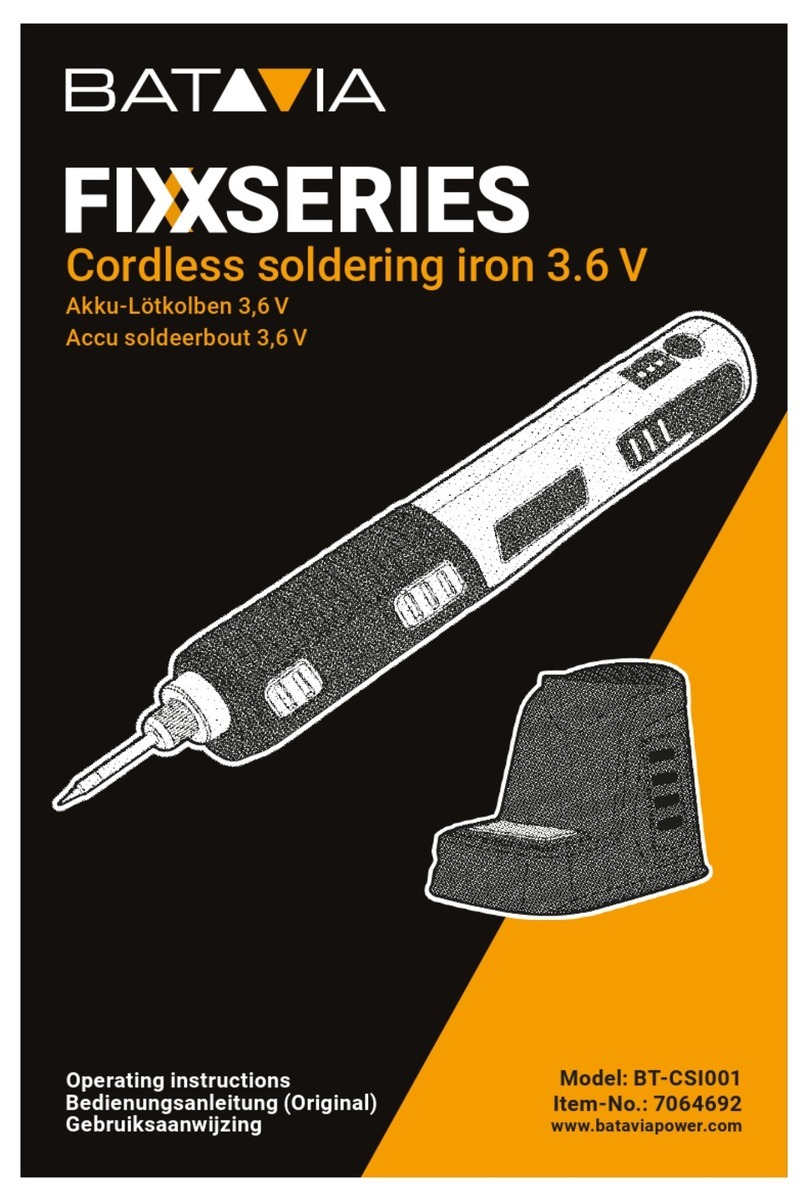
Batavia
Batavia FIXX Series operating instructions

Emerson
Emerson Klauke ES 20CFM quick start guide

Chicago Electric
Chicago Electric 61737 Owner's manual & safety instructions
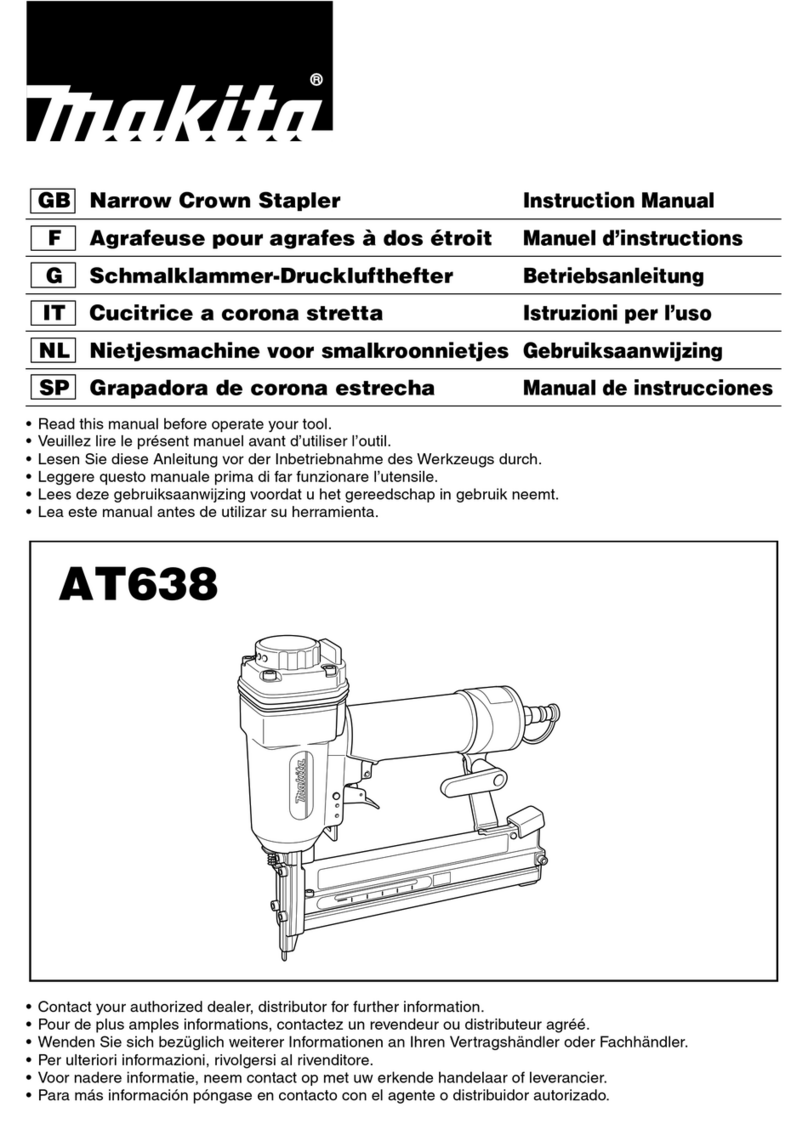
Makita
Makita AT638 instruction manual
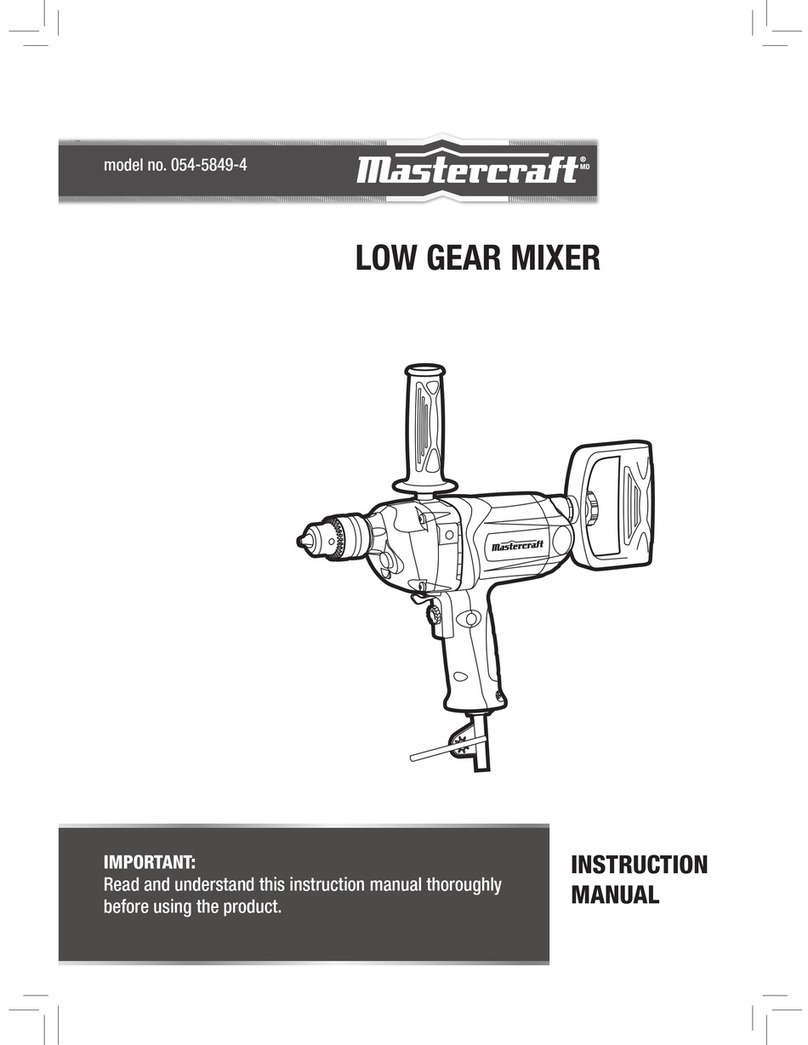
MasterCraft
MasterCraft 054-5849-4 instruction manual
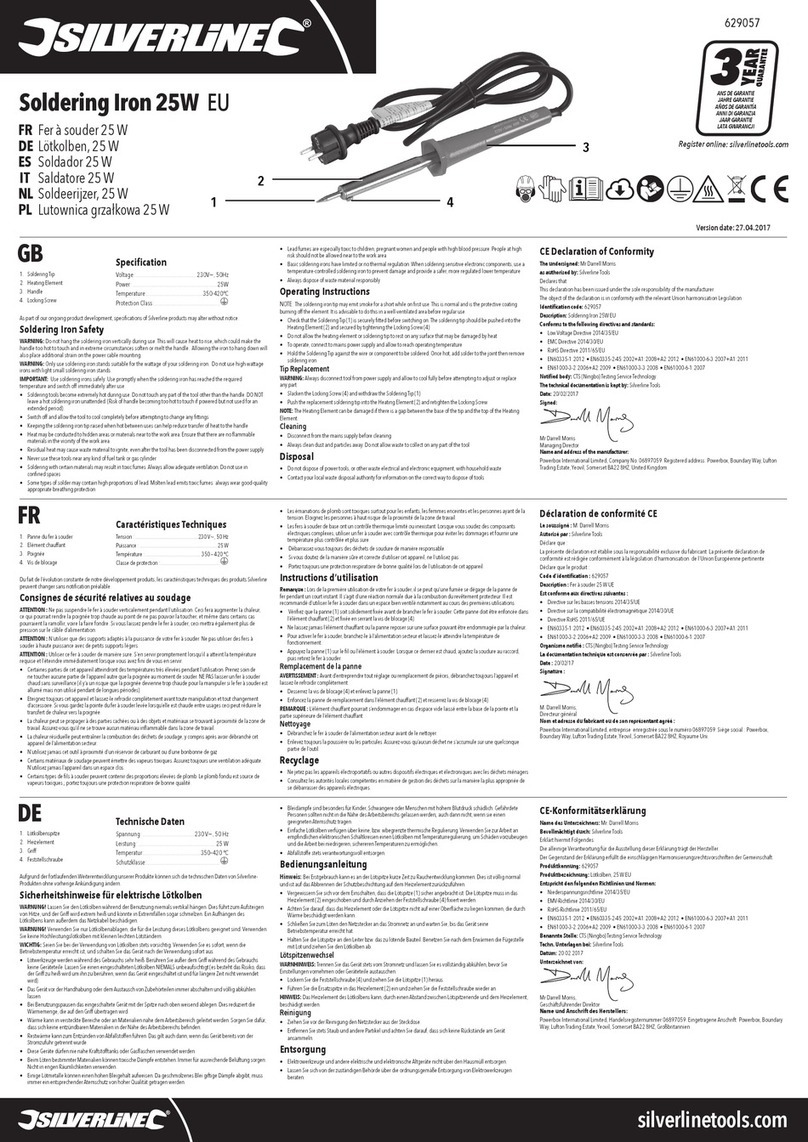
Silverline
Silverline 629057 quick guide
